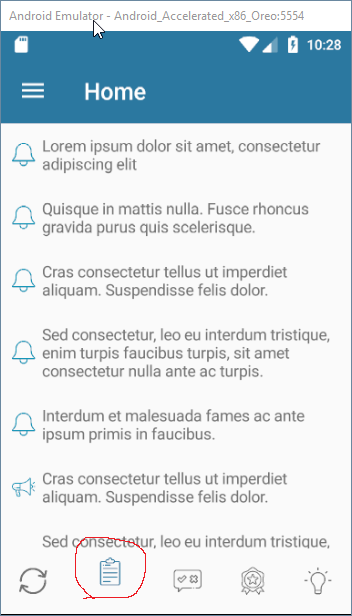I have implemented push notification on my xamarin forms project(chat application) using Firebase Cloud Messaging. Notification is receiving in all the states and when tapping the notification I need to show the corresponding message listing page.
Notification tapping is working when the app is in the foreground and background modes. But when the app is not present in the background(killed state), tapping is not working. Using DidReceiveRemoteNotification I am handling the notification tap when the app is in the background state. Using WillPresentNotification and DidReceiveNotificationResponse I am showing the notification and handling the notification tap in foreground mode. Codes added below:
//Notification tapping when the app is in background mode.
public override void DidReceiveRemoteNotification(UIApplication application, NSDictionary userInfo, Action<UIBackgroundFetchResult> completionHandler)
{
HandleMessage(userInfo);
// Print full message.
LogInformation(nameof(DidReceiveRemoteNotification), userInfo);
completionHandler(UIBackgroundFetchResult.NewData);
var myData = JsonConvert.DeserializeObject<List<webContentList>>(userInfo[new NSString("webContentList")] as NSString);
Console.WriteLine($"myData received: {myData}");
if (UIApplication.SharedApplication.ApplicationState.Equals(UIApplicationState.Active))
{
//App is in foreground, no action
}
else
{
MessagingCenter.Send<object, List<webContentList>>(this, "messagedata", myData);
}
}
//Showing the notification when the app is in the foreground mode.
[Export("userNotificationCenter:willPresentNotification:withCompletionHandler:")]
public void WillPresentNotification(UNUserNotificationCenter center, UNNotification notification,
Action<UNNotificationPresentationOptions> completionHandler)
{
completionHandler(UNNotificationPresentationOptions.Sound | UNNotificationPresentationOptions.Alert);
}
//Notification tapping when the app is in the foreground mode.
[Export("userNotificationCenter:didReceiveNotificationResponse:withCompletionHandler:")]
public void DidReceiveNotificationResponse(UNUserNotificationCenter center, UNNotificationResponse response, Action
completionHandler)
{
completionHandler();
NSDictionary userInfo = response.Notification.Request.Content.UserInfo;
var myData = JsonConvert.DeserializeObject<List<webContentList>>(userInfo[new NSString("webContentList")] as NSString);
Console.WriteLine($"myData received: {myData}");
MessagingCenter.Send<object, List<webContentList>>(this, "messagedata", myData);
}
FinishedLaunching
public override bool FinishedLaunching(UIApplication app, NSDictionary options)
{
LoadApplication(new App());
#region Push Notification
Firebase.Core.App.Configure();
// Register your app for remote notifications.
if (UIDevice.CurrentDevice.CheckSystemVersion(10, 0))
{
// iOS 10 or later
var authOptions = UNAuthorizationOptions.Alert | UNAuthorizationOptions.Badge | UNAuthorizationOptions.Sound;
UNUserNotificationCenter.Current.RequestAuthorization(authOptions, (granted, error) => {
Console.WriteLine(granted);
});
// For iOS 10 display notification (sent via APNS)
UNUserNotificationCenter.Current.Delegate = this;
// For iOS 10 data message (sent via FCM)
//Messaging.SharedInstance.RemoteMessageDelegate = this;
}
else
{
// iOS 9 or before
var allNotificationTypes = UIUserNotificationType.Alert | UIUserNotificationType.Badge | UIUserNotificationType.Sound;
var settings = UIUserNotificationSettings.GetSettingsForTypes(allNotificationTypes, null);
UIApplication.SharedApplication.RegisterUserNotificationSettings(settings);
}
UIApplication.SharedApplication.RegisterForRemoteNotifications();
Messaging.SharedInstance.Delegate = this;
Messaging.SharedInstance.ShouldEstablishDirectChannel = true;
#endregion
return base.FinishedLaunching(app, options);
}
My notification body: webContentList is my model data.
{
"to" : "dmtfiSvBBM0:APA91bFnHkamMSYgxPuiSfdvKnU8hD_mOqrWijnENNgXVSkSgo1ILH3-uKVCU7Ez2PXXOhtDoobIyKBf5UshVfTmvjSqHgXMRTsqguKCSTjIfGnXrVP-_cNFq2sisshZO-BcfkwKTl-I",
"collapse_key" : "type_a",
"notification" : {
"body" : "This is body",
"title": "Tech Team",
"priority":"high",
"content_available":true
},
"data" : {
"webContentList": [
{
"webContentDefinitionId": 818084,
"pageTitle": "CCD Grade 3-4",
"pageKwd": "CCD Grade 3-4",
"pageDesc": "CCD Grade 3-4",
"siteId": 45,
"pageCreatedTime": 1555145959428,
"pageUpdatedDate": 1555927274279,
"modifier": {
"userId": 12944,
"applicationId": 32,
"username": "robert.downey",
"email": "robert@master-mail.net",
"firstName": "Robert",
"lastName": "Downey"
},
"creator": {
"userId": 12944,
"applicationId": 32,
"username": "robert.downey",
"email": "robert@master-mail.net",
"firstName": "Robert",
"lastName": "Downey"
}
}
]
},
"ttl": 3600
}
Issue
When the app is in the killed state only the home page is loading, not showing the message listing page. But before showing the home page in the UI, the message listing show progress(acr userdialogs) is also present in the UI. So I think LoadApplication(new App()); in FinishedLaunching is working after the notification tap function when the app is in the killed state. So how I can stop the execution of the normal app launching code and show the message listing page when the app is in the killed state?

